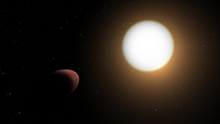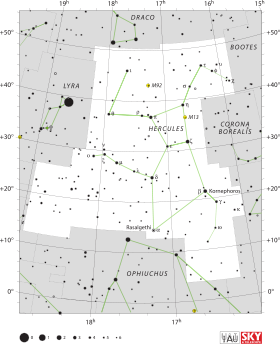WASP-103
| Ascension droite | 16h 37m 15,5765824488s |
|---|---|
| Déclinaison | +07° 11′ 00,109678740″ |
| Constellation | Hercule |
| Magnitude apparente | 12,19 |
Localisation dans la constellation : Hercule | |
| Type spectral | F8V |
|---|---|
| Magnitude apparente (J) | 11,100 |
| Magnitude apparente (K) | 10,767 |
| Vitesse radiale | −40,26 ± 1,38 km/s |
|---|---|
| Mouvement propre |
μα = −9,756 mas/a μδ = 2,779 mas/a |
| Parallaxe | 1,833 2 ± 0,107 3 mas |
| Distance |
1 800 ± 100 al (550 ± 30 pc) |
| Masse |
1,220 +0,039 −0,036 M☉ |
|---|---|
| Rayon |
1,436+0,052 −0,031 R☉ |
| Luminosité | 7,6 L☉ |
| Température | 6 110 ± 160 K |
| Métallicité | [Fe/H] = 0,06 ± 0,13 |
| Âge | 4 ± 109 a |
| Planètes | Super-Jupiter |
|---|
Désignations
2MASS J16371556+0711000
WASP-103 est une étoile de la séquence principale de type F située à 1 800 ± 100 années-lumière (550 ± 30 parsecs) dans la constellation d'Hercule. Elle possède une exoplanète de type super-Jupiter en orbite, WASP-103 b.
Propriétés
[modifier | modifier le code]La température de surface de WASP-103 est de 6 110 ± 160 kelvins (K)[1]. La concentration d'éléments lourds de l'étoile est similaire à celle du Soleil[2]. Elle est légèrement plus jeune que le Soleil avec un âge de 4 ± 1 milliards d'années[2]. L'activité chromosphérique de l'étoile est élevée en raison de l'interaction avec son exoplanète géante qui évolue sur une orbite rapprochée[1].
Une enquête de multiplicité en 2015 a trouvé un compagnon stellaire présumé pour WASP-103, à une séparation projetée de 0,242 ± 0,016″[3].
Système planétaire
[modifier | modifier le code]En 2014, une exoplanète de type super-Jupiter, nommée WASP-103 b, a été découverte par la méthode des transits[4]. L'exoplanète orbite autour de son étoile hôte en moins d'un jour et pourrait être proche de la limite de Roche[5]. Aucune décroissance de son orbite n'a cependant été détectée en 2020[6]. Début 2022, la planète a plus largement été médiatisée car une équipe d'astronomes a mis en évidence qu'elle possède une forme semblable à une pomme de terre[7].
L'atmosphère planétaire contient de l'eau et peut-être du cyanure d'hydrogène, de l'oxyde de titane(II) ou du sodium[8]. La planète a une fraction molaire carbone-oxygène élevée de 0,9 et elle pourrait être une planète carbonée[9].
La température d'équilibre planétaire est de 2 484 ± 67 K, bien qu'une grande différence existe entre le côté nuit et le côté jour. La température côté jour est de 2 930 ± 40 K, tandis que la température côté nuit est de 1 880 ± 40 K[2].
| Exoplanète | Masse | Demi-grand axe | Période orbitale | Excentricité orbitale | Inclinaison orbitale | Rayon |
|---|---|---|---|---|---|---|
| WASP-103 b | 1.455+0.090 −0.091 MJ |
0.01987+0.00020 −0.00021 |
0.9255456 ± 0.0000013 | < 0.15 | 87.3 ° ± 1.2 ° | 1.528+0.073 −0.047 RJ |
Références
[modifier | modifier le code]- (en) Cet article est partiellement ou en totalité issu de l’article de Wikipédia en anglais intitulé « WASP-103 » (voir la liste des auteurs).
- (en) D. Staab et al., « SALT observations of the chromospheric activity of transiting planet hosts: Mass-loss and star–planet interactions », Monthly Notices of the Royal Astronomical Society, vol. 466, no 1, , p. 738–748 (DOI 10.1093/mnras/stw3172, Bibcode 2017MNRAS.466..738S, arXiv 1612.01739)
- (en) A. S. Bonomo, S. Desidera, S. Benatti et F. Borsa, « The GAPS Programme with HARPS-N@TNG XIV. Investigating giant planet migration history via improved eccentricity and mass determination for 231 transiting planets », Astronomy & Astrophysics, vol. 602, , A107 (ISSN 0004-6361 et 1432-0746, DOI 10.1051/0004-6361/201629882, lire en ligne, consulté le )
- (en) Maria Wöllert et Wolfgang Brandner, « A Lucky Imaging search for stellar sources near 74 transit hosts », Astronomy & Astrophysics, vol. 579, , A129 (ISSN 0004-6361 et 1432-0746, DOI 10.1051/0004-6361/201526525, lire en ligne, consulté le )
- (en) John Southworth, L. Mancini, S. Ciceri et J. Budaj, « High-precision photometry by telescope defocussing. VII. The ultra-short period planet WASP-103 », Monthly Notices of the Royal Astronomical Society, vol. 447, no 1, , p. 711–721 (ISSN 1365-2966 et 0035-8711, DOI 10.1093/mnras/stu2394, lire en ligne, consulté le )
- (en) M. Gillon, D. R. Anderson, A. Collier-Cameron et L. Delrez, « WASP-103b: a new planet at the edge of tidal disruption », Astronomy & Astrophysics, vol. 562, , p. L3 (ISSN 0004-6361 et 1432-0746, DOI 10.1051/0004-6361/201323014, lire en ligne, consulté le )
- (en) Kishore C. Patra, Joshua N. Winn, Matthew J. Holman et Michael Gillon, « The continuing search for evidence of tidal orbital decay of hot Jupiters », The Astronomical Journal, vol. 159, no 4, , p. 150 (ISSN 1538-3881, DOI 10.3847/1538-3881/ab7374, lire en ligne, consulté le )
- (en) « Astronomers Discover Planet That Looks Like a Rugby Ball », sur NDTV Gadgets 360 (consulté le )
- (en) J. Wilson, N. P. Gibson, N. Nikolov et S. Constantinou, « Ground-Based Transmission Spectroscopy with FORS2: A featureless optical transmission spectrum and detection of H$_2$O for the ultra-hot Jupiter WASP-103b », Monthly Notices of the Royal Astronomical Society, vol. 497, no 4, , p. 5155–5170 (ISSN 0035-8711 et 1365-2966, DOI 10.1093/mnras/staa2307, lire en ligne, consulté le )
- (en) Laura Kreidberg, Michael R. Line, Vivien Parmentier et Kevin B. Stevenson, « Global Climate and Atmospheric Composition of the Ultra-Hot Jupiter WASP-103b from HST and Spitzer Phase Curve Observations », The Astronomical Journal, vol. 156, no 1, , p. 17 (ISSN 1538-3881, DOI 10.3847/1538-3881/aac3df, lire en ligne, consulté le )
Liens externes
[modifier | modifier le code]- (en) WASP-103 sur la base de données Simbad du Centre de données astronomiques de Strasbourg.
Text is available under the CC BY-SA 4.0 license; additional terms may apply.
Images, videos and audio are available under their respective licenses.


